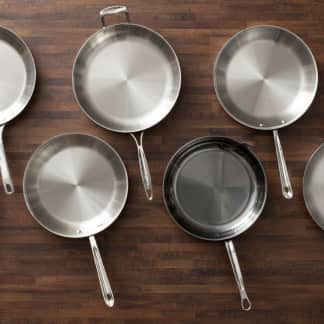After decades of testing, we still think that the Le Creuset 7¼ Quart Round Dutch Oven is the best Dutch oven on the market. It simmers, bakes, and braises beautifully. It is incredibly durable, while also being the lightest and easiest-to-use enameled Dutch oven of its size. Our Best Buy is the 7-quart Cuisinart Chef’s Enameled Cast Iron Casserole. This model is a bit heavier and less durable than our favorite, but it performs just as well and is about a quarter of the price.
If you want to spend less or if you have slightly less storage space, we also recommend the 5.5- and 5-quart versions of our winner and Best Buy. And if you’re looking for a small Dutch oven that can serve as a heavy-duty saucepan, we like the 3- and 3.5-quart versions of our favorite and Best Buy as well.
Finally, if you’re looking for a Dutch oven that isn’t made of heavy cast iron, you can read about the best alternatives in our Lightweight Dutch Oven review.
6 Rules to Follow When Cooking with a Dutch Oven
Build flavors and finish with a flourish for the best Dutch oven cooking.Is there anything you can’t do with a Dutch oven? We use these large, heavy-duty pots for boiling, searing, frying, braising, and baking and for sous vide cooking. We turn them into smokers, steamers, coolers, and panini presses. They are the true workhorses of the kitchen; many of us use them every day.
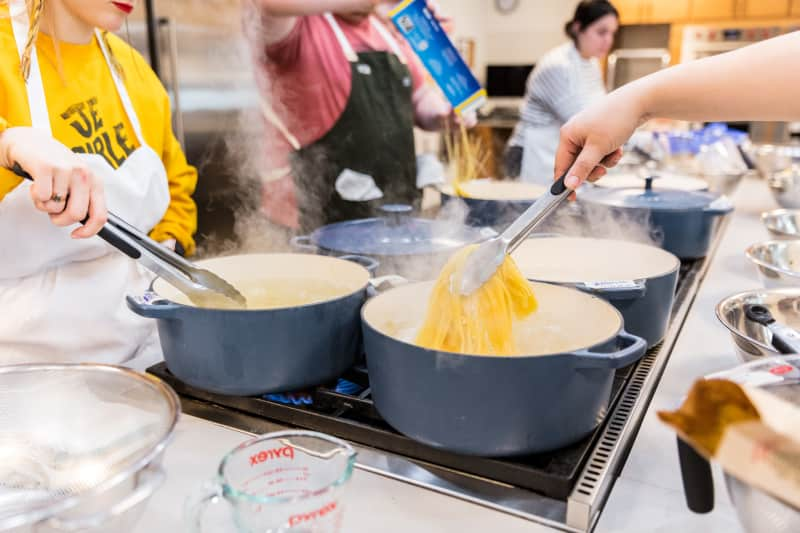
These essential pots come in different sizes and materials, though cast iron and ceramic are the most common.
What Size Dutch Oven Should You Get?
We think that a 7-quart Dutch oven is the best option for most people, as it provides ample room for anything you’d want to cook, from a whole chicken to a batch of baked ziti.
But if you’re short on storage space or funds, a smaller, less expensive 5- to 6-quart model could be the right choice. These models can do everything a 7-quart model can, from cooking full recipes of soups and stews to baking large loaves of bread—with a few minor differences. Because they’re smaller, you may need to brown meat, sauté vegetables, or deep-fry foods in more batches, and it may take a little longer to reduce sauces in them. But overall, they offer good value for their lower cost and slightly smaller footprint, and they weigh a touch less than larger versions as well.
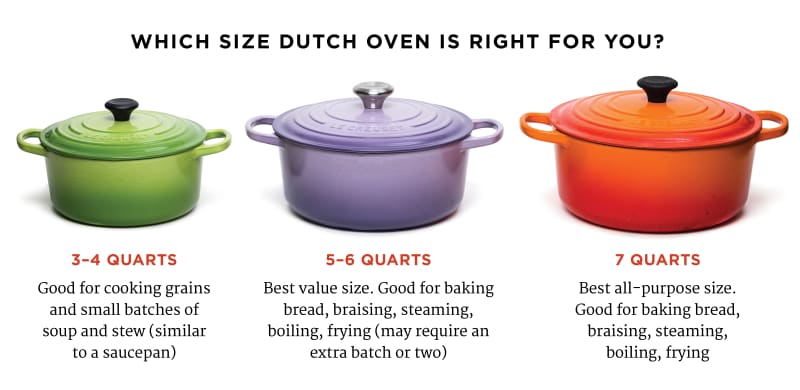
We also love even smaller Dutch ovens with capacities of 3 to 4 quarts, though they’re more limited in their capabilities. Think of them as heavy-duty saucepans—great for littler tasks, such as making rice, warming leftovers, or cooking recipes that serve two.
Are Expensive Dutch Ovens Worth the Money?
You don’t have to spend a ton to get a good Dutch oven—our Best Buys by Cuisinart perform almost as well as our expensive winners by Le Creuset and at about a quarter of the cost. But in our three decades of testing Dutch ovens, we’ve found two good reasons why you might want to spend more.
The most important is durability. In our experience, pricier enameled models are less likely to chip or get damaged over time. Treat them right, and you may never have to buy another again, saving you money in the long haul.
The other is ease of use. We’ve found that pricier models are often lighter weight than cheaper ones, making them a touch easier to maneuver and wash.
If you plan to use your Dutch oven often, it might be worth your while to invest in a more expensive model.
Regardless of size, there are a few basic characteristics that separate the best Dutch ovens from the rest.
What to Look For
- Cast Iron: We preferred models made from cast iron to those made from ceramic or other lightweight materials. Cast iron is heavy but durable, whereas the lid on one ceramic model we tested cracked when we set it down on its base. Cast iron also has excellent heat retention, so unlike vessels made from lighter materials, cast-iron Dutch ovens are ideal for baking bread and for gently braising, simmering, or deep frying foods at steady temperatures.
- Moderate Weight: Cast-iron Dutch ovens are heavy, but we prefer those that aren’t overly so. Our favorite Dutch ovens are on the lighter side of the range, making them easier to move and wash.

- Light-Colored Interiors: We slightly prefer enameled cast-iron Dutch ovens with light-colored interiors, as they provide better visibility, making it easier to monitor browning when we sear meat or caramelize onions. But Dutch ovens with dark interiors have a few advantages of their own. They radiate heat better than light-interior models, producing bread with a more deeply caramelized crust. Dark interiors also camouflage any stains that develop over time. (Light-colored interiors can look dingy after extensive use, though it’s easy to restore them.)

- Broader Cooking Surfaces: We preferred pots with generous cooking surfaces—at least 9 inches across for 7-quart models and at least 8.5 inches for 5- to 7-quart models. More usable surface area meant we needed fewer batches to brown meat or sauté vegetables.
- Lower Walls: Relatively low walls let us see into the pot more easily than taller walls and allowed sauces and braising liquid to reduce a bit more quickly.
- Large, Looped Handles: These allowed us to get a better grip on our favorite Dutch ovens so that we could move them more easily, even when our dexterity was limited by oven mitts or potholders.

- Lids with Smooth Undersides. We found simple concave lids easiest to clean. Several models came with lids that had small “self-basting” spikes or bumps covering their undersides. In theory, these spikes help cycle condensation back onto your food as it braises, keeping it especially moist. In practice, they didn’t make any difference to the flavor or texture of any of the foods we cooked. And like lids with ridges or juice grooves, they were a pain to clean, requiring more work to scrub off sauce or food flecks.
What to Avoid
- Ceramic: These pots proved too fragile for the kind of daily use we subject our Dutch ovens to.
- Small, Flat, and/or Tab-Style Handles: These were harder to grab than larger looped handles.
Other Considerations
- Enameled versus Uncoated Cast Iron: Most cast-iron Dutch ovens are coated with enamel, a type of glass. This coating is applied to every surface of the pot except its rim, making it pretty, smooth, and nonreactive; it also requires no maintenance. You can also find Dutch ovens that are uncoated—made from raw cast iron and usually seasoned with oil in the factory. We think these models have some tradeoffs. Uncoated models are often much less expensive than enameled versions, but must be maintained like any other traditional cast iron, meaning that you must dry and oil them after washing. This isn’t hard, but it is a bit more work.

In the past, when we tested uncoated Dutch ovens, we found that food cooked in them sometimes tasted metallic as a result of the chemical reactions that uncoated cast iron can have in the presence of an acid. This time around, though, we were pleasantly surprised. Tasters didn’t notice any off flavors in the food, even after we simmered an acidic tomato sauce (acid can also strip the pot’s seasoning) and then cooked fairly neutral white rice and french fries. In addition, uncoated cast-iron Dutch ovens are great for baking bread, as their dark interiors radiate heat especially well, producing crisp, well-blistered crusts. We think both enameled and uncoated Dutch ovens can be great options for cooks. If you’d like to use an uncoated cast-iron Dutch oven, it should make perfectly good food as long as you maintain its seasoning well.
The Tests
5- to 7.5-quart models:
- Boil water
- Sear meatballs and simmer them in tomato sauce
- Cook white rice
- Braise beef Burgundy
- Make French fries
- Bake Almost No-Knead Bread
- Scrub clean 10 times with abrasive sponge
- Whack rim 50 times with metal spoon
- Slam lid onto base 25 times
- Weigh and measure
3- to 4-quart models:
- Boil water
- Sear meatballs and simmer them in tomato sauce
- Cook white rice
- Scrub clean 10 times with abrasive sponge
- Whack rim 50 times with metal spoon
- Slam lid onto base 25 times
- Weigh and measure
How We Rated
- Cooking: We evaluated how well the Dutch ovens made different types of food.
- Ease of Use: We evaluated the pots on how easy they were to cook in, clean, and move around.
- Durability: We rated the pots on how well they withstood simulated long-term use.

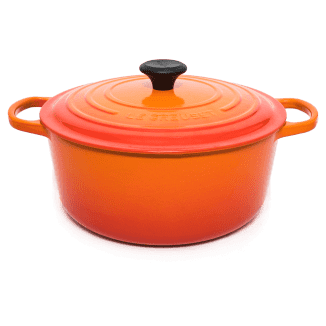






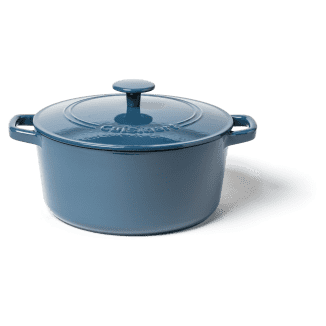



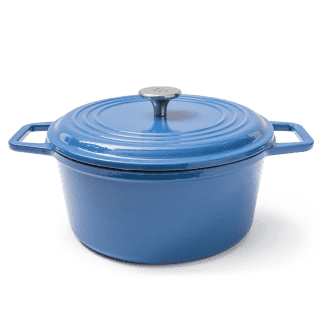




 Buy at Smithey
Buy at Smithey















 Buy at Goldilocks
Buy at Goldilocks







